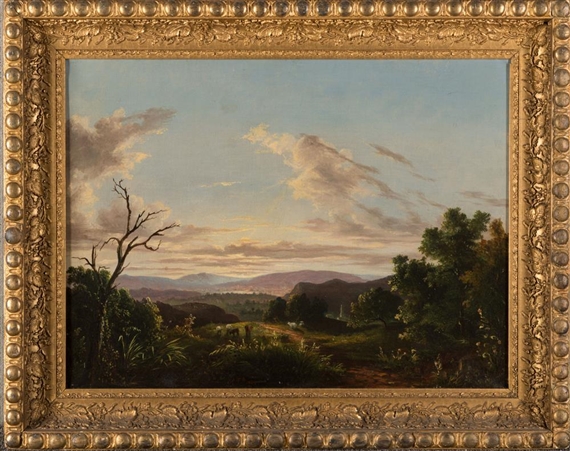To close out 2018, a year of change and upheaval for many of us, I've chosen a painter who created lovely portraits and landscapes, but who was best known for her spectacular collection of paintings depicting California wildflowers.
 |
| Alice Brown Chittenden October 14, 1859-October 13, 1944 |
Alice Chittenden was born in 1859 in Brockport, New York and moved with her family as an infant to San Francisco where her father became a prosperous miner. Alice was encouraged to study art and was one of the early women in San Francisco to study at the School of Design (the first school of art in the City) where she was a student of Virgil Williams three years after it was established in 1877. She began a long affiliation with the school as she became an art instructor and taught at the School of Design for 43 years. She was married briefly to Charles Overton in 1886, had one daughter, and never remarried. With the exception of trips to New York, Italy and France to study and to exhibit her work, Chittenden lived in San Francisco for the rest of her life until her death in 1944. She maintained a studio on the 4th floor of the Phelan Building and had a long and prolific career exhibiting her work for over 60 years.
 |
| Phelan Building San Francisco, California ca 1888 Reminiscent of the Flatiron Building in NYC |
The status of women's art in Nineteenth Century San Francisco was unique. As the seat of culture in the emerging West, the City attracted and supported a vigorous art community. The California School of Design, predecessor to today's San Francisco Art Institute, welcomed both men and women as students and instructors. California and Alaska Gold Rush dollars, Nevada Silver strikes and the completion of the Transcontinental Railroad, all contributed to affluence of the upper class and their desire to cultivate and collect art.
Women artists were studying and exhibiting art in San Francisco. The first class at the School of Design in 1874 had 46 women students out of a total of 60 (Wilson, 1983). When Alice Chittenden was appointed to the faculty in 1897 she was assigned to teach still-life drawing and painting. She became one of a few California artists who are known primarily for their work in still life paintings. Chittenden exhibited and received favorable reviews in what is thought to be the first major all-women’s art exhibition in the United States in 1885 sponsored by the San Francisco Art Association. She became the first woman juror for the Association’s art shows. Alice Chittenden and another female artist Maren Froelich were the first to break the all-male barrier at the Bohemian Club’s annual art exhibition in 1898. Chittenden was one of the charter members to organize the Women’s Sketch Club in 1906. Tragically, the 1906 earthquake and fire destroyed the headquarters of the Sketch Club along with most artists’ studios in San Francisco.
 |
| Alice Brown Chittenden A Foothill Landscape Oil on canvas board ca n.d. 7 x 9 inches |
Alice Chittenden was recognized as a prolific painter who is best-known for her paintings of over 350 varieties of California wildflowers.
 |
| Alice Brown Chittenden Poppies ca 1903 Oil on board 8 x 15 inches |
Chittenden also painted numerous landscapes, mostly of Marin County, (see Mt. Tamalpais below) and portraits done primarily in pastel.
 |
| Alice Brown Chittenden Mount Tamalpais ca 1920s Oil on canvas board 8 x 10 inches |
In 1895 an East Coast newspaper declared her the “leading flower painter of America” (Lekisch:95). In addition, she studied botany, discovering and collecting rare species of wildflowers on her excursions by stage and horseback in the Sierras and other wilderness areas which saw her sketching and painting wildflowers. Alice Chittenden exhibited in group shows including those of San Francisco Art Association, Mechanics Institute Fairs, First Annual Exhibition of Lady Artists of San Francisco, California Midwinter International Exposition, Bohemian Club, Sketch Club, golden Gate Memorial Museum and California Building all in San Francisco; California State Fair, Sacramento, California Building,World's Columbia Exposition, Chicago; California Building, Lewis and Clark Centennial Exposition, Portland, OR and solo expositions at the Schussler Gallery in San Francisco (1908), Stanford Art Gallery, Palo Alto (1918, 1922).
 |
| Alice Brown Chittenden Garden Scene ca n.d. Oil on canvas 20 x 24 inches |
Resources__________________________________________________________________________________
AskArt-Art Database, www.askart.com
Hughes, Edan Milton. 2002. Artists in California 1786-1940. Third Edition. Sacramento: Crocker Art Museum.
Lekisch, Barbara, Embracing Scens about Lakes Tahoe and Donner, Great West Books, 2003.
Silver, Mae, Shaping San Francisco Digital Archive @Found San Francisco, 1884 Midwinter Fair: Women Artists, An Appreciation, 1994. Retrieved December 31, 2018.
Phil Kovinick and Marian Yoshiki Kovinick, An Encyclopedia of Women Artists of the American West, University of Texas Press, Austin, 1998, p 46.


















